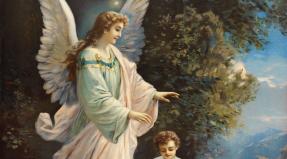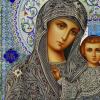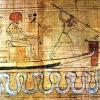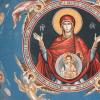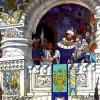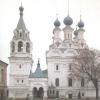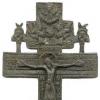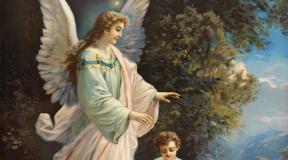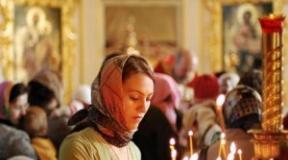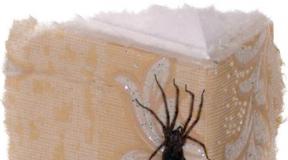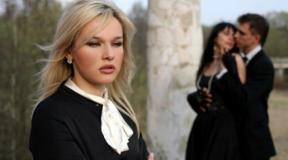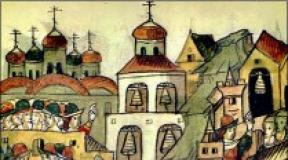Read the full miracle of George about the serpent. Miracle with the serpent that happened to the Holy Great Martyr George
The miracle of St. George about the serpent with life.
Some of the icon painters believed that St. George the Victorious subdued the monster with the word of God, and not with weapons, while others seemed at a loss in choosing what to use to strike the brave St. George, originally from Cappadocia, with the winged monster. An illustrative example here is the icon from the Church of the Dormition of the Mother of God in the village of Pogost-Sable, Batetsky district, Novgorod region, in the former Vodskaya Pyatina of Mister Veliky Novgorod. The icon is kept in the museum in the Novgorod Kremlin.

An icon from the Church of the Dormition of the Mother of God in the village of Pogost-Sable, Batetsky district, Novgorod region, in the former Vodskaya Pyatina of Mister Veliky Novgorod. Kept in the museum in the Novgorod Kremlin.
The work, created at the end of the 16th - beginning of the 17th centuries, somewhere during the reign of Tsar Boris Godunov, depicts the Miracle of St. George about the serpent with a hagiography. And there the future great martyr slays the serpent not with a spear, as we are all accustomed to seeing, but with a sword! Why is that?

Saint George slays the serpent with a sword, not a spear.
Let's start with the fact that the brave warrior George accomplished his main feat under the emperor Diocletian, when he did not renounce his faith, despite numerous tortures. Actually, the icon depicts not only the fight against snakes, but the last days of the life of the famous saint.

The image became widely known in the world.
When the persecution of Christians began, George distributed property to the poor and openly declared himself a Christian before the emperor. They arrested him and began to torture him for seven days; he was subjected to terrible torture, but his wounds were always healed miraculously: they stabbed him with spears, crushed him with a heavy stone, tortured him with a wheel studded with knives and swords, threw him into a pit with quicklime, broke the bones on his arms and legs, They were forced to walk in red-hot iron boots, beaten with whips and even poisoned.

Although this is not what the Christ-loving warrior accomplished his main feat.
George endured all this torment and did not renounce Christ. After unsuccessful persuasion to renounce and offer a pagan sacrifice, on the eighth day he was sentenced to death by beheading.

And because he accepted martyrdom, but did not renounce the Christian faith.
Where did the serpent come from then? And here is the most interesting thing. If the Greeks believed that George defeated the serpent before his death, going to Diocletian, but the Slavs believed that Saint George accomplished the feat posthumously! But is it really that important? The main thing is that this story had a happy ending.

This happened more than 1,700 years ago under Emperor Diocletian.
In the vicinity of the city of Beirut, near the Lebanese Mountains, there lived in a lake a snake that attacked people. The city was ruled by a king “a dirty idolater, a lawless and wicked man, merciless and unmerciful to those who believe in Christ.” The people, frightened by the monster, came to him asking what to do. And the king proposed to draw up a list of townspeople and, one by one, give their children to be torn to pieces by the snake, promising, when his turn comes, to give his daughter to death. Having fulfilled his promise, the king “dressed his daughter in purple and fine linen, adorned him with gold and precious stones and pearls” and ordered her to be taken to the serpent.

Georgy Georgievich was tortured for seven days.
George, seeing the crying princess, asked her about the reason for her grief and, having learned about the monster, promised to save her. “Having made the sign of the cross and calling on the Lord, with the words: “in the name of the Father, and the Son, and the Holy Spirit,” he rushed on his horse towards the serpent, shaking his spear and, striking the serpent with force in the larynx, struck him and pressed him to earth; The saint’s horse trampled the serpent underfoot.” Although we note that in some versions of the story, the snake was struck solely by the power of the saint’s prayer.

And on the eighth they beheaded.
However, more precisely, he is humble, since he was not struck to death. Then George ordered the princess to tie the snake with a belt and lead it to the city. The people were surprised by the princess's return and, seeing the snake, began to run away in horror. George addressed them with the words: “Don’t be afraid! If you believe in Christ, in whom I believe, you will now see your salvation.” And after that he beheaded a snake with a sword, whose corpse the residents carried out of the city and burned. This miracle contributed to the conversion of local residents to Christianity.

But in the people's memory, St. George the Victorious remained forever, thanks to the salvation of the princess and the entire city in modern Lebanon from the serpent.
The iconographic original gives the following lengthy description of the plot that should be depicted on the icon: “The miracle of St. George, how he delivered the maiden from the serpent, is written as follows: the holy martyr George sits on a white horse, having a spear in his hand and with it he stabbed the serpent in the larynx; and the serpent came out of the lake, great and terrible; The lake is large, next to the lake there is a mountain, and in another country there is a mountain, and on the edge of the lake stands a maiden, a royal daughter, wearing a magnificent royal robe, holding a serpent with a belt and leading the serpent with a belt into the city, and another maiden closes the city gates; the city is surrounded by a fence and a tower, from the tower the king looks, in the image of a Rus, the fortress is small and the queen is with him, and behind them are the boys, warriors and people with axes and spears.”

Having struck the serpent with a spear, George then killed him with a sword in the city.
However, in most cases, the icons depict an abbreviated composition: a warrior on horseback strikes a serpent with a spear, and Christ or his hand blesses him from heaven. Sometimes an angel with a crown in his hands is depicted above the head of George. The city is usually depicted in icons as a tower. A distinctive feature of Russian icons depicting this plot is that George strikes the dragon with a spear not in the eye, as in Western painting, but in the mouth.

And if on most icons he is depicted at the moment of defeating the dragon, then on some - at the moment of reprisal against him.
But, as we see, there was another image. Even more concise. Where it is depicted not the moment of the horseman’s victory, the pacification of the serpent, but his death from the sword of an equestrian, Christ-loving warrior.
Reads in 4 minutes
The inhabitants of the large city of Ebal, which is on the Palestinian side, have turned away from God and worship idols, honoring them according to tradition and by royal command. God rewards the inhabitants of Ebal according to their faith and deeds: a huge Serpent appears in a nearby lake, emerges from the waters and devours people. The entire population of the city turns to the king for advice on how to avoid the misfortune. The king informs them that he spoke with the gods and they told him the following: every resident of Ebal must daily give his son or daughter to be devoured by the Serpent, until the turn of the king comes, who must also give his only daughter. Everyone agrees with this decision, and everyone, starting with the king’s entourage and ending with the poorest and simplest people, every day, crying and groaning, take their children to the shore of the lake, leaving them as food for the terrible monster. Finally, no one in the city had any more children, and again everyone turned to the king so that he, too, would fulfill his promise.
The king tells them that he will give his daughter to be devoured by the Serpent, and then he will wait for what the gods will reveal to him. The royal daughter is dressed in purple, taken to the shore of the lake and left there alone. But George, the holy martyr, a sufferer for the faith of Christ, who lived even after death, by God’s permission, longs to save the inhabitants of Ebal from misfortune and, in the form of a simple warrior, finds himself at this hour on the shore of the lake. Seeing the girl, he asks her what she is doing by the lake alone. She begs the young man to leave these places as quickly as possible, and after much persuasion, she confesses to him that the king, her father, not wanting to leave this prosperous city, agreed with the command of the gods: to give the Snake all the children to be eaten until his turn.
But the great martyr George calls on the virgin not to be afraid of anything and offers a prayer to God, asking Him to show His mercy on him, an unworthy servant, and to overthrow the fierce beast, so that everyone, seeing this, would believe that there is only God, and there are no other gods except Him. A voice from heaven answers George that his request has been heard. The Virgin hears the terrible whistle of the approaching Serpent and again begs the young man to run away and leave her alone, so that he does not die with her. But Saint George, seeing the terrible Serpent, draws the sign of Christ on the ground and in the name of Jesus Christ demands that the cruel beast submit. By the power of God and the prayers of the sufferer for the faith of Saint George, the Serpent’s knees break, and George and the maiden tie him up, taking the reins from the horse and the belt from the maiden’s dress. She leads a terrible beast into the city, and the Serpent powerlessly and obediently drags behind her.
All this time, the king and queen mourn their only daughter. When they see her leading the bound Serpent, and Saint George walking ahead, the king and queen get scared and run away. But George calls on all the inhabitants of Ebal not to be afraid, but to believe in our Lord Jesus Christ, in whom alone lies salvation. Having learned that the name of the beautiful young man is George, everyone, as one, raises their voices, exclaiming: “Through you we believe in one God, the Almighty, and in His only begotten Son, our Lord, Jesus Christ, and in the Holy Life-giving Spirit.” George cuts off the head of the terrible Serpent with his sword, and the king and all the inhabitants of Ebal praise God. The Tsar commands to build a church in the name of the great martyr and sufferer for the faith, George, and from now on commemorate him in the month of April.
Saint George, seeing that they all believed in our Lord Jesus Christ, promises to show them a new miracle. When the construction of the church is completed, he sends his shield to the craftsmen to hang it over the holy altar. And since then the shield has been hanging in the air without any support. All who come to this church with faith, through the prayers of Saint George, are healed from sorrows and illnesses and rejoice when they see the miraculous deeds of the saint.
Retold
“The Miracle of George about the Dragon” begins with the emotional exclamations of the author: “How can I tell about this terrible and glorious sacrament? What will I say and what will I think about? How to start talking and narrating...” The author is worried, doubts whether he, a sinner, will be able to adequately tell about the “most wondrous” of all the miracles of George. This beginning prepares the reader for the fact that we will be talking about something extraordinary - about a “terrible and glorious sacrament.”
In ancient times, the author says, the inhabitants of the city of Ebal worshiped pagan gods and their idols (statues). For their “beliefs and deeds,” retribution was sent down on them: a huge snake settled in a lake near the city, devouring the inhabitants of Ebal. The townspeople turned to the king for advice, and he told them the will of his pagan gods: every day one young man or girl should be given to the snake to be eaten. And all the inhabitants, obediently following the will of the gods, each in turn gave their children to the terrible monster, and he carried them away and ate them.
It was the king’s turn. It was bitter for him to part with his only daughter, but he did the same as all the townspeople and ordered the girl to be taken to the shore of the lake. The girl obediently awaited her fate. The holy warrior George, returning from the war and hurrying to his native place, found himself at that time on the shore of the lake. He started asking the girl why she was standing there. The defenseless girl, left to be devoured by the snake, began to beg the unknown warrior to leave quickly: she felt sorry for the young and handsome, “bright-faced” stranger who could die because of her. “I see your pleasant appearance, and your youth, and the lightness of your face - but how horribly you will die!” - the girl exclaims, hurrying George.
Despite the girl’s persuasion, George does not leave her; he acts like a true warrior of Christ and a knight who must protect the weak and suffering. Before entering into single combat with the snake, George turns to God in prayer and asks him for help. And God gives him his blessing. “Go for it, Georgy!” - proclaims a voice from heaven. And then a huge snake appears from the lake. He resembles a monster from Russian folk tales: his head hangs like a vault, and his mouth is like an abyss. With a roar, the monster moved towards George and the girl. But George did not flinch; he was confident in God’s help. Having crossed the earth, George said: “In the name of Jesus Christ, the Son of God, submit, you cruel beast, and follow me.” And the serpent fell at the feet of George. Then he ordered the girl to tie the snake by the head with her belt and reins from his horse and lead it to the city. And the terrible snake obediently, like a sheep, moved after her, dragging along the ground.
Seeing the snake, the city residents became frightened and ran away in horror. But after making sure that the snake was no longer scary, they believed in their salvation. And the inhabitants of Ebal realized that their gods were powerless, for they did not help them get rid of the serpent. And they believed in God, who saves and protects, who gives those who believe in him the power to defeat the most terrible monsters. And as if once again confirming this, George, in front of all the inhabitants of Ebal, cuts off the head of the fierce snake with a sword.
The king ordered the construction of a church in the name of St. George and decorated it with silver and expensive stones. And George sent his shield to the inhabitants of the city and ordered it to be hung in the church. So in the church altar that shield hangs in the air, not supported by anything. This ends “George’s Miracle on the Dragon” (summary).
Why is the story about a young warrior who defeats a huge snake so beloved by Russian readers? Each nation had its own myths and legends, telling about a hero who entered into single combat with a snake, dragon or monster. There were such heroes in Russian folk tales and epics. Victory over the monster was given to the hero for his nobility, kindness, desire to help people and animals. In fairy tales and epics, nature helped the noble hero, miraculously he received extraordinary strength and defeated the ferocious monster. In the Christian legend, God himself helps George to “dare,” that is, to be bold and decisive, since the hero’s thoughts and intentions are noble. The ideal of masculine beauty, embodied in Christian legend, was close and understandable to Russian people.
Okhotnikova V.I. Old Russian literature: Textbook for grades 5-9 / Ed. O.V. Tvorogova. - M.: Education, 1997
“The Miracle of St. George about the Serpent” as an objective reality, or an anti-Darwinian analysis of the battle of the most famous ancient Roman Christian officer.
photo — Sergey Evdokimov
The author was prompted to write this article by the current situation in the Middle East, where once again Christian weapons are confronting the forces of world evil, and this is happening on the territory where the holy Great Martyr George once killed a certain dragon, although few people now remember about this moment. By the will of fate, Russia has recently been an active participant in the confrontation in this region, but many Russian military personnel heading there, if they know St. George, then in the most general terms, and some do not consider him a historical figure at all and, unfortunately, perceive his victory over the dragon like a legend. However, we will try to dispel their doubts.
The Great Martyr George, called the Victorious, is one of the most famous and revered saints by Orthodox Christians. People turn to him for various prayer needs, but first of all, people serving in the military pray for his intercession before God. This saint is also one of the special patrons of Christian weapons, and many victories of Christian troops on the battlefield are attributed, among other things, to his intercession.
Images of the Holy Great Martyr George the Victorious, separated by 15 centuries.


Modern Orthodox image “The Miracle of St. George about the Serpent.”
Firstly, it must be said that the surviving sources are quite unanimous that St. George was a real historical figure; he was a high-ranking ancient Roman officer who served during the reign of Emperor Diocletian. According to one of probably the most historically accurate versions, the Great Martyr George was born into a family of Greco-Roman aristocrats in the small Palestinian town of Lydda (now Israeli Lod) at the end of the 3rd century. He died in 304 AD. for his faith in Christ, while still at a fairly young age, on the territory of ancient Cappadocia (Asia Minor) in the city of Nicomedia (now Turkish Ismid).
Here we would not like to repeat the story of the saint’s suffering before death, which usually occupies a significant part of his life, if only on the grounds that it seems somewhat strange to force, for example, someone to repeat again and again the description of the monstrous torment and death of some the person he dearly loved. Anyone can find easily accessible information about these events; we are especially interested in, perhaps, the most striking and memorable episode for contemporaries that happened during the saint’s earthly life - a battle in which he defeated a certain monstrous creature called a dragon or a large serpent.
For some reason, in our time, even many Christian believers (not to mention representatives of other religious denominations or atheists) believe that in fact there was no battle, and this is some kind of legendary symbol of the victory of the Christian faith over paganism. However, the high degree of realism and detail of the events described does not give reason to think so.
Some, being captive of the modern scientific worldview, built on the unproven ideas of Darwinism and based on the evolutionary picture of the world, suggest that the battle itself took place, but St. George struck some large lizard, such as a Komodo dragon, or even a crocodile. However, skeptics for some reason forget that there have never been huge monitor lizards in the Middle East, and Indonesia with the island of Komodo (where giant monitor lizards live) is very far away, and until the 19th century nothing was known about them in the Mediterranean. People in that region had been hunting crocodiles for a long time and successfully, and it is unlikely that the killing of one, even a particularly large, crocodile could have influenced contemporaries in such a way that thousands of them subsequently became convinced Christians. Below we will try to understand this and still answer the question - so with whom did St. George the Victorious actually fight?
So, the Great Martyr George, being an officer in the Roman army and at the same time a deeply religious Christian, was once on business in the territory of modern Lebanon or Western Syria and came to one large city. Here the sources differ: according to one version, it was the city of Beirut (Berita), according to some other sources, perhaps we are talking about Aleppo (Aleppo) or another settlement in that region is indicated. There he learned that at some distance from this city there was a swampy lake, declared sacred by local pagan priests, on the shores of which a certain reptilian monster settled. And it would be good if it just lived there - so this creature at first hunted sheep and cows, which were kept by residents of the surrounding villages, and then, when the livestock ran out, it switched to feeding on people.
Apparently, attempts by local pagans to kill the dragon or drive away the monster with the help of magic did not yield results. The situation has reached the point of, in simple Russian language, simply insanity, since local priests (apparently acting in line with the ancient Babylonian tradition) decided that this animal is sacred, that it settled here by the will of the gods, and is itself the embodiment of some ancient deity , which means trying to kill him is a sin. But the main thing is that they convinced the entire people that in order to please the pagan deities, “in order for them to change their anger to mercy,” human sacrifices must be made to this terrible creature.
Over time, this abominable practice became “a pious tradition.” Even the Roman consul himself, who ruled this province (sometimes called “king” in some lives), agreed with her when the sacrificial lot fell on his relative or even daughter. Having learned about this, Saint George, who was in that area, having a chivalrous character, decided to show that the God of Christians is much stronger than any pagan monsters. In addition, the saint saw that, according to God’s Providence, it was he, “here and now”, who was given the opportunity to testify to the power of the Lord, and decided to correct the situation.
The panic-stricken pagans did not hear the entreaties of the few local Christians about the need to stop the sacrifices, and the future great martyr did not enter into battle with them, shedding the blood of his fellow citizens, even if they were committing lies. He decided to act differently. And when the procession with the next bound victim (probably it was the daughter of the imperial administrator) went out to the dragon’s habitat, he went with them, however, dressed in armor, armed and mounted a war horse. And as you can understand, it was not at all for the purpose of indifferently contemplating the terrible picture of the atrocity.
When people brought the doomed woman to the lair of the monster, and she crawled out, hoping to have a hearty lunch once again, Saint George suddenly found himself alone entered into a duel with a dragon on the lake shore, and killed " the serpent's fierceness", saving the life of a girl doomed by lot to a terrible sacrifice, thanks to which tens of thousands of residents of Lebanon and Western Syria were baptized en masse. This is how this battle is described in one text: “ ...having made the sign of the cross and calling on the name of the Lord, Saint George quickly and bravely rushed on his horse towards the serpent, tightly grasping the spear and, striking the serpent with force in the larynx, struck it and pressed it to the ground; The saint’s horse furiously trampled the snake underfoot..." It can be stated that the matter was decided by an unexpected and quick, perfectly executed attack (it was not for nothing that the Great Martyr George was a professional warrior).
Moreover, as the text of some biographies of the saint testifies, having struck, but not finished off the monster, the Victorious One dismounted from his horse, threw a rope over the defeated enemy, and with the words “ And this is your god? Well, look how I handle him!"He led the dragon to the city. And only there, at its walls, and not on the shore of the lake, in the presence of a crowd of people, the valiant saint cut off the monster’s head, glorifying the name of the Lord Jesus Christ, and glorifying Him as the True and Only God, who grants victory to those who firmly trust in Him.
Thus, our Lord, through Saint George, showed his mercy to people, not only by defeating the deified monster, but by interrupting the disgusting tradition of human sacrifice. Moreover, it was through the demonstrated valor of St. George that many local residents accepted Orthodox Christianity (different sources give different figures - from many thousands to 24,000 and even up to 240,000; we are talking about a truly huge number of residents of the area, although it is clear that no one kept accurate records ). And so, thanks to the accomplished feat, a significant proportion of the local population realized the fallacy of belief in the power of pagan deities, and, rejecting the Middle Eastern cults, accepted faith in That God, who proved that He is stronger than all dark forces and their biological creatures.
However, despite the fact that the Roman authorities subsequently probably approved the very act of fighting and killing the “fierce serpent”, regarding it probably “as protecting the lives of the emperor’s subjects,” the spread of Christianity in the Late Roman Empire of the late 3rd century was considered not just “politically incorrect” ", but was expressly prohibited by law. And it was precisely the conversion of tens of thousands of Roman citizens to Christ through his feat that, apparently, was imputed to Saint George later, becoming one of the points of official accusation.

 Late medieval German image (15th century) of St. George slaying the dragon.
Late medieval German image (15th century) of St. George slaying the dragon.

 Italian fresco 14th century. (artist Botticelli), depicting St. George slaying the serpent.
Italian fresco 14th century. (artist Botticelli), depicting St. George slaying the serpent.

 Modern paleontological reconstruction (art. Z. Burrian) - nothosaurus on the shore of the lake.
Modern paleontological reconstruction (art. Z. Burrian) - nothosaurus on the shore of the lake.
Seeing the medieval images of the battle of St. George with the serpent, and comparing them with the modern reconstruction of the nothosaurus discovered by paleontologists, one can only be amazed at the obvious identity of the predatory reptiles. Moreover, even the size of the notozar approximately coincides with the image of the dragon struck by St. George - it was not a giant dinosaur at all, although it was quite agile and clearly aggressively predatory, adult specimens of which reached a length of 3-4, sometimes 5 meters.
Despite the fact that the dragon or snake with which the saint fought differs among different artists, it seems that some of the most ancient images clearly go back to a single tradition, according to which this reptile had a huge head with a large mouth, a thin and relatively long neck , a short thick body on four legs and a rather long tail. There is no mention of any several heads, wings for flight, fiery breath or other fabulous attributes of the monster either in the most ancient images or in the lives of St. George. There is a complete feeling that we are looking at some very real animal, but one that was extremely rare even in Antiquity and is now completely extinct.
For a long time, numerous skeptics and even some Christian believers believed that there was nothing real in the story of the battle of St. George with the serpent. However, quite a long time ago, paleontologists during excavations found a species of dinosaurs, which received the name nothosaurs. These were quite large predatory creatures that lived in ancient times along the shores of lakes, seas or rivers, perhaps even leading a semi-aquatic lifestyle, and thus we can state that the living conditions - that of the dragon struck by St. George, that of the notosaurus - are similar. Apparently, a significant part of their diet was fish, but, first of all, nothosaurs were active predators, and attacked any prey that appeared in the immediate vicinity of their habitat (even the bones of young notosaurs were found with traces of the teeth of larger individuals).
Since quite a lot of skeletons of these ancient predatory reptiles were found, scientists were able to fairly accurately restore their appearance. However, for a long time, for some reason, no one compared the images of the snake on the images of St. George and the paleontological reconstructions of the notosaurus, which (in our opinion) coincide perfectly, down to the details (at least the author did not come across information about this).
It is somewhat surprising that some creationists (i.e., supporters of the concept of the creation of the world by God and opponents of materialistic Darwinism) currently believe that St. George fought with the dinosaur Baryonyx (first found, and then only fragmentarily, only in 1983, although by Our time knows several fairly complete skeletons of individuals of this species). However, this was hardly possible, because Although Baryonyx also lived along the banks of reservoirs, like Notosaurus, it had a slightly different appearance, moved mainly on two legs rather than four, and was much larger than Notosaurus, which means it was more difficult to hit it with a simple spear and then tie it up and Saint George would hardly have been able to drag a half-dead “dragon” onto a rope into the city (unless we are talking, for example, about a young individual of Baryonyx). Whereas the nothosaurus, not only in its appearance, but even in size, ideally corresponds to the predatory reptile described in the life of the martyr knight and the surviving medieval images of the most famous battle of this Christian saint.

 Reconstruction of the appearance of the largest dinosaur species found, Baryonyx walkeri, compared to the size of a human (height 1.8 m). However, it turned out that it was still a young individual, which means that the size of the peak specimens of this species was much larger.
Reconstruction of the appearance of the largest dinosaur species found, Baryonyx walkeri, compared to the size of a human (height 1.8 m). However, it turned out that it was still a young individual, which means that the size of the peak specimens of this species was much larger.

 A group of Baryonyx in its traditional habitat - on the shore of a pond. The versatility of this predator's diet is well demonstrated.
A group of Baryonyx in its traditional habitat - on the shore of a pond. The versatility of this predator's diet is well demonstrated.
As you can see, an adult Baryonyx was, firstly, much larger than a notosaurus, and secondly, it walked mainly on two legs, and not on four, which means that it is unlikely that representatives of this particular species are depicted on icons with St. George (since its skull alone was up to 2 meters long, which means that St. Victorious could hardly drag a half-dead dinosaur of this species to the city residents on a rope, while the notosaurus corresponds perfectly in all respects).
And, as surprising as it may seem to skeptics, not only the size of the “dragon”, judging by the images of the battle of St. George, coincides with the size of the found skeletons of nothosaurs (usually reaching a length of 2-4 meters, sometimes 5-6 meters, like Nothosaurus giganteus), but even their habitat is identical (unlike Baryonyx, which reached a length of 9 meters, and whose bones were found only in England and Spain). Paleontologists, based on the finds of bone remains of notosars, believe that the habitat of this species of lizards included territories from North Africa and Southern Europe through the Middle East and Southern Russia all the way to Central Asia. Thus, it can be argued that the presence of notosaurus on the territory of modern Lebanon or Western Syria, where it was killed by an ancient Roman Christian cavalry officer, does not contradict the available scientific data on the habitat of this species.
However, for evolutionists who deny the Creation and the biblical picture of the development of our planet, there is one problem - from their point of view, the life time of the Holy Great Martyr George of Nicomedia and both Notosaurus and Baryonyx are separated by tens of millions of years, since in their opinion, dinosaur and man There was no way they could live in the same historical era. But this is true only if we rely on the concept of the development of the world, built on the erroneous theory of macroevolution of Charles Darwin and share the hypothetical chronology of evolutionists in billions of years. If we base our concept of the development of the world on the Book of Genesis, share the biblical chronology and recognize the Creation of our world by God (in the absence of macroevolution as a reliably recorded phenomenon), then it is not impossible that Saint George could kill one of the last nothosaurs in battle.
We will not examine here the many other known cases where the presence of living dinosaurs (one way or another causing harm and therefore usually killed by humans) is recorded in ancient Hebrew, ancient Babylonian, ancient Greek, ancient Roman or medieval European and Arabic documents, but we will simply emphasize that the case of the battle St. George the Victorious against the dinosaur is not isolated evidence. And accordingly, not only the life of St. George and some other Christian serpent-fighting saints, but numerous descriptions preserved in ancient sources of dinosaurs through the eyes of eyewitnesses as creatures living side-by-side with people, as well as their ancient images, give strong reasons to believe that some of these lizards survived a certain Global Cataclysm, called the Flood, and were exterminated by man already during Late Antiquity and the Early Middle Ages.
 Modern icon of St. George
Modern icon of St. George
Thus, the available evidence suggests that the picture of the development of life on our planet proposed by evolutionists and presented by them as the only true picture of the development of life on our planet is conceptually erroneous, while the biblical picture of the world explains the existing seemingly paradoxical facts quite well.
And we hope that the same Power of the Lord, which in ancient times helped the Great Martyr George to crush the living embodiment of evil, will help Orthodox Christian soldiers in our time (if they firmly believe in Jesus Christ and trust in the intercession of St. George) to crush all their opponents.
Miracle of George about the serpent
Mid-14th century
- Onasch 1961: XIV century.
- Smirnova 1976: Second half of the 14th century.
Tretyakov Gallery, inv. 12868.
Second half of the 14th century.
55×37.
Origin. From the collection of A.V. Morozov. Since 1918, it has been in the Museum of Russian Artistic Antiquities, established on the basis of this collection; in 1926, together with this collection, it was transferred to the State Historical Museum, in 1930 it entered the Tretyakov Gallery 1.
1 About the meeting of A.V. Morozov, see: V. I. Antonova. Old Russian painting in the State Tretyakov Gallery. - V. I. Antonova, N. E. Mneva, pp. 23–24, 27.
Revealed until 1917 (reproduced in its current state in the book by A.V. Grishchenko).
Board solid linden, without keys. The ark. Pavoloka is not visible. The soil layer is thin.
Safety. It is possible that the original painting was poorly preserved and was greatly “edited” by the restorer during cleaning, in accordance with the tastes of pre-revolutionary icon painters and collectors. A black drawing is written. The wings and head of the dragon also raise doubts about the authenticity. Perhaps the outlines of the right slide turned out to be changed: traces of purple paint are visible in the background, as if left over from a cleared area.
The background and margins were probably light yellow; In some places traces of remaining dye 2 are visible. The halo has tinting.
2 Wed. information about the collector’s tastes: “Morozov preferred a gesso background freed from gold or paints, reminiscent of yellowish ivory in its color...” (ibid., p. 24).
It can be assumed that the inscription on the background, as well as the Calvary cross with the accompanying inscription, were “corrected” by restorers.
Description.
George is presented on a black horse. At the bottom left is a black cave, from which a blue-gray crawls out. With. 238
With. 239¦ a dragon with red, black and yellow wings. With a long spear, George pierces the dragon's mouth. On the sides there are symmetrical slides: light yellow on the left, lilac-brown on the right. At the top right is a green segment of the “sky” with a blessing hand.
The saint is dressed in a cinnabar cloak, a green shirt, yellow trousers and brown plate armor with yellow and green trim. On the head is a white stemma crown with red and green “stones”. The halo is yellow. Behind the shoulder is a brown shield with a yellow border and blades. Horse harness in the form of cinnabar ribbons with whitewash “pearls”. The tail is tied with a white cord. The face of George is painted convexly, with a system of gray-sankir (mainly in the shadows) and light yellow ocher strokes, with cinnabar blush on the cheeks and in the shadows and with light white highlights. The hair is depicted in black curls on a cinnabar base, with yellow strokes - “highlights”.
The background and margins are currently white. The frame along the husk and the edge on the upper margin are cinnabar.
On the sides of the halo there is a columnar cinnabar inscription with the charter: ![]()
Near the blessing right hand:
On the upper field, a Calvary cross is drawn in olive-sankir paint with the inscription: ![]()
Iconography.
3 V. N. Lazarev, N. E. Mneva. Monument of Novgorod wooden carving of the 14th century (Lyudogoshchensky cross). - “Communications of the Institute of Art History”, vol. 4–5. M., 1954, illus. on page 156.
What is new for the icons of this subject is the presence of a “blessing right hand”. This brief iconographic excerpt was subsequently widely distributed in Novgorod icons, which is associated with the veneration of St. George the Dragon Fighter among the people.
Dating and attribution.
The dating of the icon ranges from the 13th century. (A.V. Grishchenko, Yu.A. Olsufiev) until the 15th century. (A.I. Nekrasov, p. 174, caption under Fig. 114]). Most often it is dated back to the 14th century. (A.I. Nekrasov, p. 172), more precisely - by the time around the middle of the century (V.N. Lazarev, N.E. Mneva).
The icon was probably created no earlier than the mid-14th century. Evidence against an earlier time is evidence of familiarity with the artistic techniques of the 14th century, which were still little known in the Novgorod “folk” painting of the first half of the century: spatial composition, pictorial modeling with pure or slightly tinted white.
The face of George is characteristic of the second half of the century (for the type of face compare, for example, the fresco of 1364 in the paraklis of St. Gregory the Theologian at the Church of Periveleptus in Ohrid) 4 .
4 P. Mikovic-Pepek. About slikarim to Metropolitan Jovan and Jeromonk Makari. - “Moravian school and Jeno doba. Learn stingy from Resavi. 1968". Beograd, 1972, p. 241, seq. I.
In the type and painting of the face, the icon reveals similarities with the figures of warriors in the upper tier of the icon “Nativity of the Mother of God, with selected saints”, second half of the 14th - early 15th centuries. (cat. no. 28). A rare detail also coincides: the image of strands of hair in the form of bright colored curls.
The columnar arrangement of the letters of the inscription is a relatively early feature. However, A. S. Orlov attributed the style of the letters to the end of the 14th century. According to O. A. Knyazevskaya, the shape of the letters does not correspond to the usual styles of the 14th century. in manuscripts.
M. V. Alpatov emphasizes the archaism of the monument: with its static nature, the composition resembles the central image in the hagiographic icon of St. George from the collection of M. P. Pogodin in the State Russian Museum (cat. No. 10).
Literature.
Read also...
- Briefly about the periods and styles of Russian architecture
- What types of crosses do you see on cops?
- Myths of Ancient Egypt. Part 1. The daily life of the Greek gods The Greek gods decided to invite them to a feast
- Multivariate social development (types of societies) The basis of the economy of country B In a traditional society, routine technologies prevail


